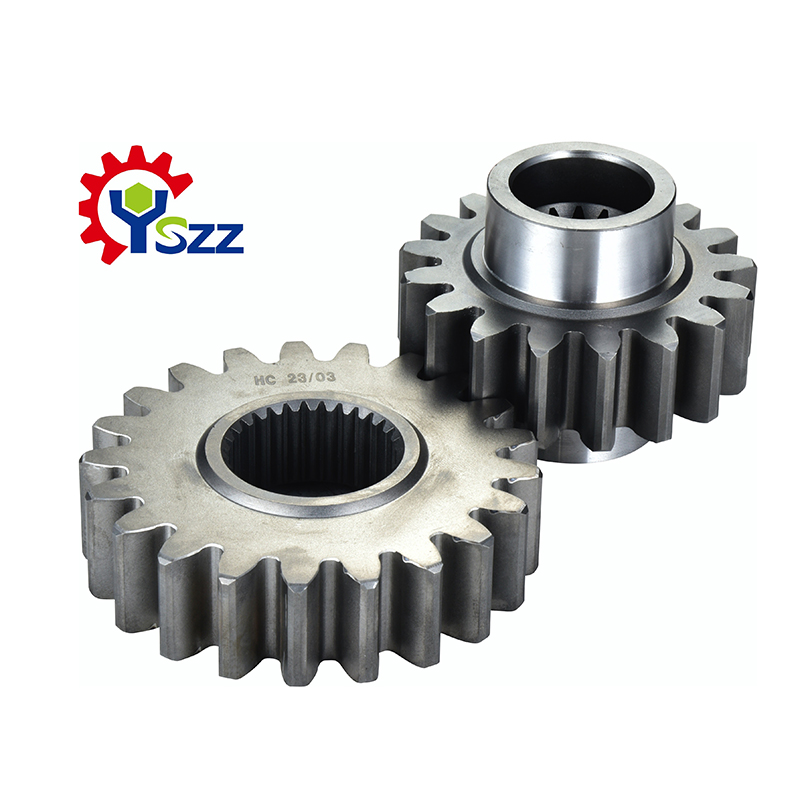Hypoid gears are a unique category of spiral bevel gears that are used to transmit rotational power between two shafts at right angles. Invented by Ernest Wildhaber in the early 1920s, hypoid gears were used predominantly in the drive trains of heavy trucks.
At the time, the genius of the invention was the offset between gear shafts, which allowed the truck frame to be lowered. This development had a profound impact on vehicle designs, leading to significant improvements in available space within the vehicle, roll stability, vehicle handling, safety, aerodynamics, and gas mileage. While hypoid gears are still used in this capacity, they also have a growing presence in the industrial power transmission and motion control industries. Bevel Gear Catalog

Hypoid gears can be classified as a type of bevel gear used to transmit rotational power, or torque, between two shafts at right angles. There are two primary categories of bevel gears: straight teeth and spiral teeth. Spiral teeth bevel gears have proven to run smoother and quieter than straight teeth bevel gears and it is these spiral bevel gears that hypoids most closely resemble.
In contrast to standard bevel gears, the mating gear shafts for hypoid gear sets do not intersect because the smaller gear shaft (referred to as the pinion) is offset from the larger gear shaft (referred to as the crown). It is these non-intersecting axes that Mr. Wildhaber designed with the rear axle in mind, leading to the vehicle performance improvements described above.
The axis offset allows the pinion diameter to be larger and have a greater spiral angle than would otherwise be possible, which increases the contact area and tooth strength. The spiral angle between the pinion and crown causes the gears to mesh very smoothly. Increased contact area and tooth strengh allow for a wider range of gear ratios and the ability to transmit higher amounts of torque.
Additional benefits resulting from the increased spiral angle and contact area between hypoid gear sets include reduced wear and tear, lower friction, lower energy loss, and higher efficiency, all of which help extend the life of hypoid gears and gearboxes.
Due to their increased spiral angle and tooth strength, hypoid gears can carry load across several teeth simultaneously. The average number of hypoid gear teeth in contact at one time is 2.2:1 to 2.9:1. Bevel gears, on the other hand, are loaded one gear tooth at a time. More tooth-to-tooth contact allows hypoid gears to transmit greater torque compared to similarly sized bevel gears. In addition to transmitting more torque, hypoid gears and gearboxes tend to be smaller and more compact than bevel gearboxes with equivalent torque ratings, making them a better choice for applications involving tight spaces.
Bevel gears and bevel gearboxes are most common in ratios of 1:1 and 2:1, with some manufacturers providing ratios up to 5:1. By contrast, hypoid gears do not provide solutions for 1:1 and 2:1 applications. However, they efficiently achieve ratios from 3:1 up to 10:1, providing more ratio options with a single gear stage. Reduction ratios are relevant to speed, where hypoid gearboxes enjoy another significant advantage over bevel gearboxes. Most bevel gearboxes cannot handle speeds over 1,500 rpm without overheating, whereas hypoid gearboxes can reach continuous input speeds up to 3,000 rpm.
The mesh between hypoid gearsets involves a sliding action, resulting in a very smooth and quiet transmission. Subsequently, higher loads can be transmitted with lower noise levels compared to bevel gears, which become noisy at higher speeds.
Hypoid gears offer more ratios, higher torque capacities, higher running speeds, and less noise than their bevel counterparts. However, hypoid gears are usually less efficient (90 to 95%) than a similar set of spiral bevel gears, which can have efficiency ratings up to 99%. The efficiency of hypoid gears decreases as the axis offset increases and special attention must be given to lubrication to prevent gear wear as a result of the sliding action of hypoid gear teeth. Hypoids require lubrication with extreme pressure additives, whereas bevel gears can operate with standard gear grease or oil.
Packaged bevel gearboxes have another advantage over hypoids. Bevel boxes offer multiple shaft options; many bevel gearboxes are available in 2, 3, and 4 shaft configurations. If an application requires a 1:1 or 2:1 transmission, a transmission with 3 or 4 outputs, or efficiency ratings above 95%, then bevel gears may be the best option. Outside of these criteria, hypoid gears are replacing bevel gears in a number of applications.
The other popular type of right-angle gearing that hypoids are encroaching upon is worm gear technology. For decades, worm gears were the popular choice for right-angle speed reduction because they are robust and relatively inexpensive. With a favorable cost-to-torque ratio and the ability to offer a large range of ratios in single stage — typically from 3:1 up to 100:1 — worm gearing is widely used across a number of manufacturing industries. Today, however, hypoid gears may be a better alternative for many reasons.
While hypoids enjoy a large speed advantage over worm gears, the most impactful difference between these two types of gearing is efficiency. Compared to worm gears, hypoids are far more efficient at transmitting power, especially at high reduction ratios and low speeds. Most hypoids are between 90% and 95% efficient versus similar sized worm gearing, which varies between 40% and 85%. Additionally, hypoid efficiency remains constant over a wide range of ratios and speeds, whereas the efficiency of worm gearing varies with both ratio and speed.
Greater efficiency has many benefits, beginning with energy savings. More efficiency means smaller motors can be used to drive machines, reducing up-front purchasing costs as well as reducing long-term energy and maintenance costs. Efficiency also affects heat generation. Hypoid gears run much cooler than worm gears, which can lead to an advantage in the expected life of the gears.
The trend today is to make everything smaller and more efficient and hypoids help achieve these goals. The efficiency advantage that hypoids have over worm gearing is significant and hypoids are far more compact and can fit into tighter physical spaces than a worm gear arrangement with similar torque capacity. As mentioned above, machines can use smaller, less expensive motors as a result of higher efficiencies, further reducing the machine footprint. Time costs money and so does space, giving hypoids another advantage over worm gears.
Worm and worm wheel gearing does have a few advantages over hypoid gears. Worm gears can provide ratios up to 100:1 or more with single-stage gearing, whereas in single stage, most manufacturers provide hypoid gearboxes up to 10:1. Also, due to the inefficiency and high ratios of worm gears, many worm gear drive applications are self-locking, eliminating the need for holding torque or an external brake. With efficiencies up to 95%, hypoid gears are not self-locking; it is possible for the transmission to backdrive in the absence of holding torque or a brake.
The up-front purchase price of hypoid gears may also be more expensive than comparable worm gears and gearboxes. However, the numerous performance benefits of hypoid gears — such as higher efficiency, higher precision, higher speed, higher torque capacity, and smaller footprint — may prove hypoid technology to be more cost effective over time. For premium performance and long-term cost savings, hypoid gears have become an attractive alternative to worm gears and the growth of hypoids in the power transmission industry is a testament to this fact.
Another enormous advantage that hypoid gearing has over both bevel gears and worm gears is precision or accuracy measured in gear tooth backlash. Bevel gears, particularly spiral bevel gears, can be made in sets to be very accurate, down to about 6 arc minutes backlash. Most worm and worm wheel gearing, however, have far more backlash in the gear tooth mesh, making them unsuitable for many applications beyond power transmission.
Hypoid gears can achieve backlash specifications as low as 3 arc minutes, making them far more accurate than either bevel or worm gear arrangements. This level of precision, combined with the many other established advantages, has allowed hypoid gearing to go beyond power transmission and to penetrate the motion control market.
Hypoid gears are now commonly used across a wide spectrum of automation and motion control applications. Their performance characteristics make them ideal for both low- and high-speed applications as well as high-cycle-rate applications that require extreme precision. Available in single- and two-stage arrangements, packaged with a planetary gear stage, hypoid gearboxes offer a wide range of ratios from 3:1 up to 100:1.
Precision planetary gearboxes have been present in the motion control industry for many years. In order to convert an inline planetary arrangement into a right-angle reducer, gearbox manufacturers incorporated a set of spiral bevel gears to make the 90-degree turn. In the past several years, these bevel gear sets inside multi-stage, right-angle planetary gearboxes are being replaced with hypoid gears, resulting in more compact, efficient, and precise gearboxes.
Most manufacturers have designed motor flanges on the input of these hypoid gearboxes to allow for a variety of motors, including metric and NEMA servo motors, to mount directly to the gearbox housing. Whether used in a single-stage right-angle gearbox or in conjunction with planetary stages, hypoid gears have a growing presence in the motion control industry.
It is unlikely that Ernest Wildhaber could have anticipated that his invention would travel well beyond vehicle drivetrains and into the world of industrial power transmission and motion control. Upon reviewing the design characteristics of hypoid gears, it is easy to see why this technology has experienced such significant growth.
Compact, high speed, high torque, high efficiency, extreme precision, low noise, low heat, and long life — these performance characteristics are synonymous with hypoid gears and gearboxes. The combination of these traits has made hypoid gearing an increasingly popular speed reduction solution for the growing demands of today’s power transmission and motion control industries.
This article was contributed by Candy Controls, Niles, IL. For more information, visit here .
This article first appeared in the December, 2021 issue of Motion Design Magazine.
Read more articles from this issue here.
Read more articles from the archives here.
EV Battery Recycling Still Being Defined
4D Printing with Smart Materials
Leaders Optimistic North America Lithium Supply Gap Can be Eliminated
Zinc-Air Batteries: A Cheaper, Safer Alternative to Li-ion Batteries
2023 Battery Show North America Opens as Automakers, Suppliers Intensify...
How Much Do You Know About Drones?
Software Solutions for Battery Management System Applications With AUTOSAR
Leveraging Electronics Digital Twins on AWS to Accelerate Software-Defined Vehicle Validation
Choosing a Silicone for Operation in Harsh Thermal Environments
Scan-Based and Project Design for Medical
Introduction to the Integration of Electronics Switching and Modules in Commercial Vehicles
Miniaturized Solutions for Battery Development
By submitting your personal information, you agree that SAE Media Group and carefully selected industry sponsors of this content may contact you and that you have read and agree to the Privacy Policy.
You may reach us at privacy@saemediagroup.com.
You may unsubscribe at any time.

Designing Bevel Gears © 2009-2023 SAE Media Group
